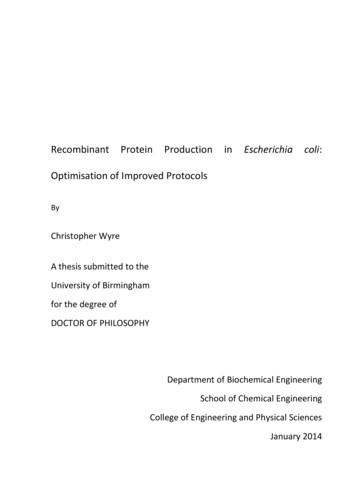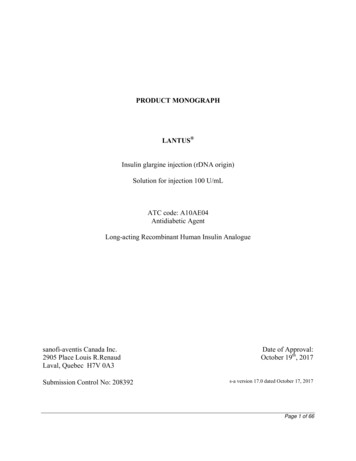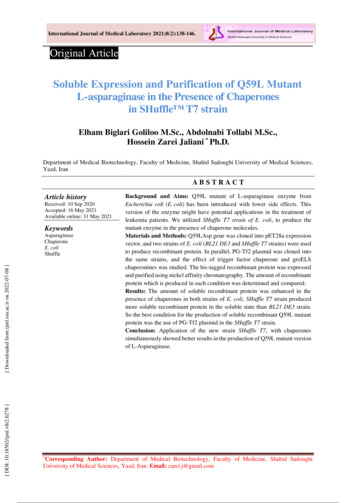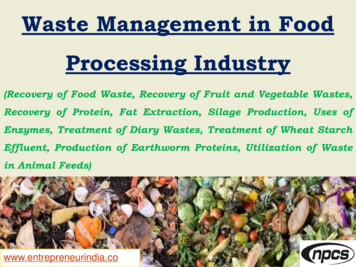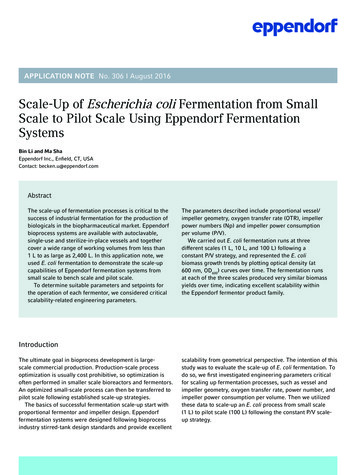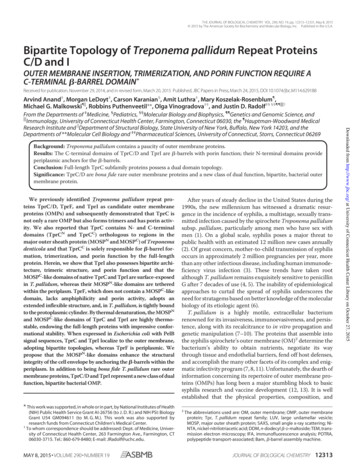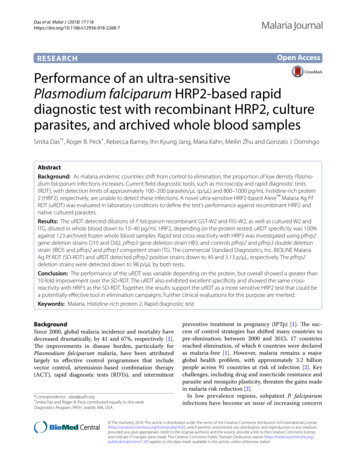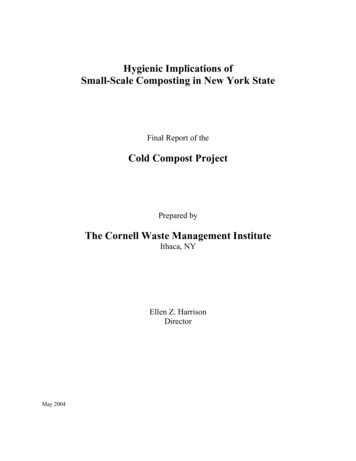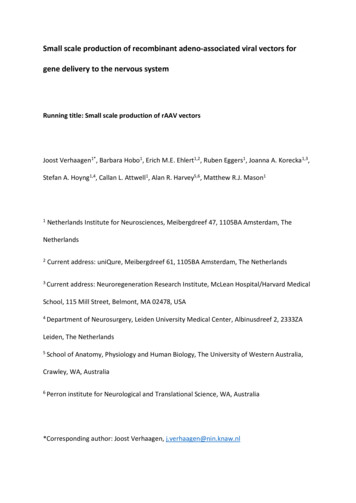
Transcription
Small scale production of recombinant adeno-associated viral vectors forgene delivery to the nervous systemRunning title: Small scale production of rAAV vectorsJoost Verhaagen1*, Barbara Hobo1, Erich M.E. Ehlert1,2, Ruben Eggers1, Joanna A. Korecka1,3,Stefan A. Hoyng1,4, Callan L. Attwell1, Alan R. Harvey5,6, Matthew R.J. Mason11Netherlands Institute for Neurosciences, Meibergdreef 47, 1105BA Amsterdam, TheNetherlands2Current address: uniQure, Meibergdreef 61, 1105BA Amsterdam, The Netherlands3 Currentaddress: Neuroregeneration Research Institute, McLean Hospital/Harvard MedicalSchool, 115 Mill Street, Belmont, MA 02478, USA4 Departmentof Neurosurgery, Leiden University Medical Center, Albinusdreef 2, 2333ZALeiden, The Netherlands5 Schoolof Anatomy, Physiology and Human Biology, The University of Western Australia,Crawley, WA, Australia6 Perroninstitute for Neurological and Translational Science, WA, Australia*Corresponding author: Joost Verhaagen, j.verhaagen@nin.knaw.nl
AbstractAdeno-associated viral vectors have numerous applications in neuroscience, including thestudy of gene function in health and disease, targeting of light-sensitive proteins toanatomically distinct sets of neurons to manipulate neuronal activity (optogenetics), and thedelivery of fluorescent protein to study anatomical connectivity in the brain. Moreoverseveral phase I/II clinical trials for gene therapy of eye and brain diseases with adenoassociated viral vectors have shown that these vectors are well-tolerated by humanpatients. In this article we describe a detailed protocol for the small scale production ofrecombinant adeno-associated viral vectors. This protocol can be executed by investigatorswith experience in cell culture and molecular biological techniques in any well-equippedmolecular neurobiology laboratory. With this protocol we typically obtain research batchesof 100 – 200 μL that range in titer from 5 x 1012 to 2 x 1013 genomic copies/mL.Key wordsAdeno-associated viral vector, production, purification, serotype, iodixanol, Amiconcentrifugation device1.IntroductionAdeno-associated virus (AAV) is a non-pathogenic parvovirus belonging to the subfamily ofdependoviruses. Dependoviruses cannot replicate autonomously but need a helper virus fortheir propagation. Adenovirus or herpesvirus can serve as helper virus for AAV. AAV istherefore a “replication defective” virus by nature. The genome of AAV consists of three
open reading frames encoding the rep and cap proteins and the assembly activator protein,flanked by inverted terminal repeats (ITRs). The cap genes encode the capsid proteins andthe rep genes are required for DNA replication which only occurs in the presence ofadditional helper functions provided by the helper virus1.Over the last three decades protocols have been developed to generate and purify high titerstocks of recombinant adeno-associated viral vectors (rAAV). In early methods to producerAAV an adenovirus was required as helper virus. As a result, batches of rAAV werecontaminated with adenovirus. The identification of the adenoviral genes required for thepropagation of rAAV vectors has allowed the creation of a rAAV production system that isentirely plasmid based2-5. Today the nine most commonly used rAAV serotypes areproduced by dual or triple plasmid transfections in human embryonic kidney (HEK) 293Tcells. In the dual plasmid production system the transfer plasmid contains the gene ofinterest under the control of a promoter flanked by the ITRs from AAV2 and the helperplasmid harbors the AAV2 rep genes, the cap genes of a specific AAV serotype and theadenoviral helper functions3. In the triple plasmid production system the rep and cap genesand the adenoviral helper functions resent on two different plasmids6. Thus, for each rAAVserotype the helper plasmid harbors the specific cap genes of the desired serotype.Serotypes 1 to 6 are produced through the dual plasmid system and serotypes 7 to 9 bymeans of the triple plasmid system. Large scale production protocols for rAAV in eitherinsect cells7,8 or mammalian cells9 have also been developed. These production systems aremainly used to generate large amounts of rAAV for preclinical or clinical studies.In this article a simple four stage production protocol is provided for the generation ofrelatively small quantities (100-200 μl) of rAAV with a titer typically ranging between 1 x
1012 to 2 x 1013 genomic copies/mL. The first stage involves the production of rAAV by cotransfection of two or three plasmids (the transfer plasmids mixed with one or two helperplasmids depending on the rAAV serotype) in HEK293T cells. In the second stage rAAV iscollected from the transfected cells and concentrated by iodixanol gradientultracentrifugation. Thirdly, rAAV from the iodixanol gradient is concentrated and separatedfrom cellular proteins by multiple washes and centrifugation in Amicon centrifugal filterdevices. Fourth, the titer of the rAAV sample is determined by quantitative PCR (qPCR) onrAAV genomic DNA. This protocol is a modification and extension of original protocolsdeveloped earlier and can be completed in 7 to 8 working days4,5,10,11. Finally, we describeour method to deliver rAAV to the brain12-15 and to the retina by intravitreal injection16,17.2.Materials2.1.Reagents for cell culture and PEI-mediated plasmid transfection1. DMEM: Dulbecco’s Modified Earl’s medium supplemented with 10% fetal calf serum(FCS) and 1% v/v penicillin/streptomycin (PS)2. IMDM: Iscoves Modified Dulbecco’s medium supplemented with 10% FCS/1% v/vPS/1% v/v glutamine (GLN).3. PEI solution: add 500 mg Polyethylenimine (PEI, 25kD, linear, powder) to 450 mL H2Oand lower the pH to 2.0 with 12 N HCl to dissolve the PEI. Adjust the pH with 10 MNaOH to 7.0. Adjust the volume to 500 mL yielding a PEI solution of 1 mg/mL. Thesolution is stored in frozen aliquots after sterilization through a 0.2 μm filter.4. HEK293T cells: Human embryonic kidney-derived 293T cells5. Plasmids: helper plasmids required for each serotype are specified in Table 1.
6. 15 cm tissue culture plate[Table 1 near here]2.2.Reagents for rAAV harvest and Iodixanol gradient centrifugation1. Iodixanol: start with a 60% solution to generate the 15, 25 and 40% solutions asfollows:15% iodixanol: dilute 60 mL 60% Iodixanol with 48 mL 5 M NaCl and 48 mL 5x PBSMK (5x PBS with 5 mM MgCl₂ and 12.5 mM KCl), add water to a volume of 240 mL.25% iodixanol, dilute 67 mL 60% Iodixanol with 32 mL 5x PBS-MK, add water to avolume of 160 mL.40% iodixanol, dilute 160 mL 60% Iodixanol with 48 mL 5 x PBS-MK, add water to avolume of 240 mL.2. DNaseI: 10 mg DNaseI/mL PBS3. D-PBS: Dulbecco’s phosphate buffered saline (Gibco)4. Alternative lysis buffer: 50 mM Tris pH 8.5, 150 mM NaCl, 0.1 % Triton X-100, 2 mMMgCl22.3.Reagents for Amicon filter centrifugation concentration1.D-PBS2.D-PBS with 5% sucrose: 5 g sucrose in 100 mL D-PBS, store aliquots at -20ᵒC
2.4Reagents for rAAV titering1.Titration DNaseI solution: 250 µg/mL DNAase I in D-PBS supplemented with 3mMMgCl22.52.1 M NaOH for alkaline lysis3.Neutralization solution: mix 1 part 1 M Tris pH8 and 4 parts 1.25 M HCl4.Master mix: SYBRgreen solution (Applied Biosystems).5.Primers: designed against your sequence of interest (see Note 1)6.qPCR plate (MicroAmp optical 96 well reaction plate)7.PCR thermocycler with heated lidSpecialist devices and equipment for rAAV production1. Cell Scraper with a length of 28 cm (Greiner Bio-One)2. Amicon ultra-15 centrifugal filters 100k (Merck Millipore UFC910024)3. Vortex4. Ultracentrifuge: a Beckman L-80 ultracentrifuge or equivalent ultracentrifuge5. Table-top centrifuge with inserts for 50 mL tubes e.g. Eppendorf 5810R centrifuge,and inserts for qPCR plates6. 70Ti Beckman rotor7. PCR system with heated lid e.g. Biorad T1008. qPCR system e.g. a 7300 real time PCR system of Applied Biosystems9. 19G needle
10. 30G needle11. Pasteur pipette12. Ultracentrifuge Quick-Seal polypropylene tube (Beckman)13. Biohazard hood14. Metal clamp15. Latex or nitrile gloves16. Screw-top 1.5 mL tube17. Serological pipettes2.6Equipment and reagents for delivery of rAAV to the brain and retina1. Sterilized surgical equipment, including a scalpel handle, forceps, fine scissors (finescience tools), a dental drill, cotton swabs, eye ointment, and different size sutures.2. 50 µL Hamilton for injection of AAV into the vitreal chamber of the eye3. Automated microinjection device; Harvard apparatus or Nanojet3. Stereotactic apparatus (Kopf)4. Custom pulled glass capillaries 1.5 mm OD x 0.86 mm ID (#30-0053, Harvardapparatus) with an 80 µm tip diameter.5. Polyethylene tubing 0.61 mm OD x 0.28 mm ID (#800/100/100 Portex, Smithsmedical)6. Two component epoxy resin (combi rapide, Bison)7. Mineral oil when using a glass micropipette attached to a Hamilton syringe viapolyethylene tubing8. Heating pad
9. Isoflurane equipment, lidocaine (local anaesthetics), Sterile water (fill needlesystem), Fynadine (2.5mg/kg s.c. flunixin)10. Inhalation anesthesia using a mixture of (0.2 L/min) O2 and (0.4 L/min) medicinal aircontaining 1.6% isoflurane11. 70% ethanol12. PTFE Luer Lock and a cannula with appropriate size to fit the inner diameter of thepolyethylene tubing3.Methods3.1 Cell culture and PEI-transfectionDay 1.1. Plate 1 to 1,25 x 107 HEK293T cells (passage number not higher than 20) per 15 cmtissue culture plate in DMEM in a tissue culture incubator at 37oC and in 5% CO2.Prepare 8 plates for a typical batch of rAAV (see Note 2).Day 2.2. Check HEK293T cells around 3 PM. The cells should have grown to 70 to 80%confluency. The transfection efficiency drops significantly when cells are tooconfluent.3. Pre-warm IMDM in a water bath to 37oC. Per 15 cm plate you will need 20 mL ofIMDM.4. Replace DMEM with IMDM two hours before the transfection.
5. Thaw the PEI solution (A) and prepare the plasmid solution (B) for transfectionaccording to Table 2. For AAV 1 to 6 a two plasmid system is used. For AAV 7 to 9 athree plasmid system is used (Table 1).6. Mix A and B (1:1) and vortex immediately. Incubate for 15 minutes at RT.7. Add the mixture to the HEK293T cells in IMDM. Per plate add 2 mL of solution in adropwise fashion. Ensure that the solution is equally distributed over the cells.8. The plates are returned to the tissue culture incubator and transfected cell arecultured until the next morning (16 – 18 hours after the transfection).[Table 2 near here]Day 3.9. Prewarm IMDM in a water bath to 37oC.10. Replace IMDM with fresh IMDM, 20 mL per plate. Process one plate at a time toprevent cells from drying out.11. If the transfer plasmid contains a fluorophore (e.g. GFP) it is possible to check thetransfection efficiency under an inverse fluorescence microscope. At this point intime around 30% of the cells should express detectable GFP.Day 4.12. Check the condition of the cells under the inverse microscope. Cells shouldappear viable and the proportion of transfected cells has increased toapproximately 60 to 80% (see Note 3). For rAAV serotypes 1 to 6, 8 and 9 rAAV is
harvested on day 5. However, for AAV7 we consistently observed that thetransfected cells start to detach from the cell culture dish on day 5 and with thisserotype we therefore start the rAAV harvest on day 4.3.2 Harvest of rAAV and iodixanol gradient ultracentrifugationDay 5.1. Aspirate medium from the cell culture plates. Two plates at a time.2. Add 3 mL D-PBS to the first plate. Scape the cells from the first plate with a cellscraper. Aspirate the harvested cells and add this mixture to the second mediumfree plate and remove the cells by cell scraping. Collect the cell mixture in a 50mL tube. Repeat this until cells from all plates have been harvested. Total volumeof the cell harvest of 8 plates should not exceed 17,5 mL because otherwise itcannot be applied on the iodixanol gradient.3. Freeze/thaw cells three times by freezing in dry ice-cooled ethanol and thawingin a 37oC water bath until completely thawed.4. After each freeze/thaw cycle check for large cell clumps in the solution. If theseoccur vortex the solution to break up cells clumps.5. Alternative method: Scrape in alternative lysis buffer. Use 16 mL total. This isquicker for harvesting but the detergent can cause bubble formation during theiodixanol gradient step.6. Add 25 μL DNAseI, incubate for 1 hour at 37oC in a water bath. (see Note 4)7. Store the cell lysate at -20oC. Continue with the iodixanol densityultracentrifugation the next day.
3.3. Iodixanol gradient centrifugationDay 6 .1. Defrost the cell lysate in a 37oC water bath.2. Centrifuge lysate for 30 min at 3220 x g in a table centrifuge.3. Apply a maximum of 17,5 mL of cell lysate to the bottom of a Beckmanultracentrifuge Quick-Seal polypropylene tube with a Pasteur pipet (see Note 5).4. Replace the Pasteur pipette with a new one. This pipette will be used tounderlayer the iodixanol gradient solutions (Figure 1).5. Gently infuse 9 mL of the 15% iodixanol solution under the cell lysate andcontinue with 5 mL of the 25% and 40% iodixanol solution and finally 3 mL of the60% iodixanol solution (Figure 1; see Note 611).6. Fill the tube with D-PBS to the bottom of the neck (but not into the neck) toremove any remaining air bubbles. A 1 mL syringe with a 19G needle can be usedfor this (see Note 7).7. Seal the tube using the electrical tube topper. Ensure that the neck of theBeckman tube is dry because the tube will not seal properly if the neck is wet.Carefully squeeze the sealed Beckman tube to make sure that the tube is indeedfully sealed and not leaking.8. Centrifuge in Beckman centrifuge in a 70Ti fixed angle rotor for 70 minutes at69.000 rpm at 16oC.9. After centrifugation open the rotor in the biohazard hood and assemble the firstBeckman tube in a metal clamp (see Note 8).
10. Puncture a small hole in the top of the tube with a 30G needle. Leave the needlein place.11. Puncture a hole in the bottom of the tube with a 19G needle. First gently removethe 19G needle, subsequently remove the 30G needle and close the hole withyour gloved finger. To collect the iodixanol fractions in steps 12 and 13 slowlyallow air into the centrifuge tube via the hole punctured with the top 30Gneedle.12. Collect the first 2 mL of iodixanol (60% iodixanol) in a 15 mL tube and discard.13. Collect the next 3 mL of iodixanol (1 mL of 60% and 2 mL of 40% iodixanol). Thisfraction contains your rAAV.[Figure 1 near here]3.4. Amicon filter centrifugation of rAAV, washing and concentration1. Dilute the 3 mL iodixanol solution that contains the rAAV (step 3.3.13) with 12 mLD-PBS. Mix well.2. Apply this solution to an Amicon ultra 15 device.3. Concentrate by centrifugation at 3220 x g for 15 minutes at RT to reduce thevolume to approximately 500 µL. Additional centrifuging time may be necessary.4. Discard the flow through.5. Add 15 mL of D-PBS plus 5% sucrose to the concentrated rAAV solution.6. Centrifuge at 3220 x g for 10 minutes at RT to approximately 500 µL.7. Repeat this at least three times (see Note 9).
8. In the last Amicon wash and concentration step centrifuge until the volume ofyour rAAV solution is between 150 and 200 µL. Additional centrifuging may benecessary to reduce the volume to this.9. Transfer your rAAV to a screw-top 1.5 mL tube and store at -80oC (see Note 10).3.5 rAAV titrationDay 7.1. Add 2,2 μl of rAAV stock to 85,8 µL of Titration DNAseI solution. Mix well bypipetting and divide in two aliquots of 40 μl in PCR tubes (this is a 1:40 dilution)2. If necessary spin the samples a few second at 200 x g in the micro centrifuge tocollect the sample at the bottom of the tube.3. Incubate 30 minutes at 370C in the PCR thermocycler with heated lid.4. Incubate 3 minutes at 120C in the PCR thermocycler with heated lid.5. Spin down for a few second at 200 x g in the table centrifuge to collect thesample at the bottom of the tube.6. Add 40 µL of 1 M NaOH and vortex briefly (see Note 11).7. Spin the samples a few second at 200 x g in a table-top centrifuge to collect thesample at the bottom of the tube.8. Incubate 15 minutes at 500C in the PCR thermocycler with heated lid.9. Add around 40 μl neutralization solution (exact volume determined previously,see Note 11) to each sample. Vortex and spin down at 200 x g.10. From each sample take 20 µL and dilute in 180 µL H2O (1 : 10 dilution). Keep thesamples on ice and continue with step 11 or freeze at -200C and continue later.
11. Prepare a standard curve for the qPCR using a reference plasmid.12. First make a solution of 1010 molecules/mL. For example, using pTR-CGW (FW3496 kD), this is 58.4 pg/µL. 16.7 µL of pTR-CGW (1 µg/µL) is diluted in 5 mL H2Oresulting in a 4 ng/µL stock solution. 5895 µL of H2O is added to 105 μl of the4ng/µL stock giving 58.4 pg/µL, or 1010 plasmid molecules per mL. Make 1:10serial dilutions to a final dilution of 103 plasmid molecules per mL. These serialdilutions can be stored and used for a number of standard curves in the future.Vortex thoroughly before each use.13. Prepare reaction mix for the qPCR in qPCR plate. Total volume per reaction is 25μl. For each reaction: 12,5 μl SYBRgreen master mix, 0,75 μl primer mix (10 μM offorward and reverse primer, see Note 1), 10 μl rAAV DNA (step 11) or 10 μl fromthe serial dilutions of the standard curve, and finally 1,75 μl H2O. Spin the qPCRplate at 200 x g for a few second.14. Place qPCR plate in the qPCR machine and start the cycling: First cycle: 2 minutes500C, 10 minutes 950C; 40 cycles: 15 seconds 950C, 1 minute 600C; Dissociationstage: 15 seconds 950C, 1 minute 600C, 15 seconds 950C, 15 seconds 600C, cooldown to RT.15. Calculate titers from the cycle threshold values using the standard curve, takinginto account the dilution steps in the procedure (an initial 1:40 dilution, the 1:3dilution during alkaline lysis and neutralization and the last 1:10 dilution, giving afinal dilution of 1:1200).3.6 Stereotactic delivery of rAAV to the brain (in some jurisdictions this procedureneeds to be performed in a suitable biosafety cabinet)
1. Tubing is connected to the glass needle by application of the two componentresin. The opposite side is mounted onto the Hamilton syringe needle, afterwhich the system is back-filled using demi water.2. The rat is deeply anesthetized with inhalation anesthesia using a mixture of O2(0.2 L/min) and medicinal air (0.4 L/min) containing 1.6% isoflurane.3. The fur on the skull is shaved and the skin surface is cleaned with 70% ethanol.4. The animal is placed in a stereotactic frame and fixed by ear and tooth bars.5. A skin incision is made and lidocaine is topically applied to obtain additional localanesthesia.6. Stereotactic coordinates for intraparenchymal injection are obtained fromPaxinos and Watson (see Note 12).7. A dental drill is used to drill a small hole in the skull at the intended coordinates.8. Prior to the injection of the vectors the meninges are punctured with a sharp 30Gneedle in order to prevent brain contusion during lowing of the injection needlein the brain parenchyma.9. A pressure injection of 1 µL rAAV is performed by lowering a glass needleconnected to an automatic microinjection device through the hole in the skull tothe appropriate depth. The microinjection device is turned on and the vector isinjected at a speed of 0.1- 0.2 µL/min.10. After the injection the needle is left in place for 3 minutes to prevent back-flowof the viral vector solution.11. Subsequently the needle is gently retracted and the skin is sutured. Peroperative, the animal is kept on a heating pad and an injection of fynadine isadministered to obtain adequate analgesia during recovery.
12. If an injectable anesthetic is used the animal should be left on a heating pad for 2to 3 hours to recover.3.7 Delivery of rAAV to the retina – intravitreal injections (in some jurisdictions thisprocedure needs to be performed in a suitable biosafety cabinet)1. A sterile pulled glass micropipette (with a relatively shallow profile, tip about200-300 μm) of known internal diameter (to readily establish volume ofinjection) is attached via mineral oil filled polyethylene tubing to a 50 μl Hamiltonsyringe (preferably via PTFE Luer Lock and a cannula with appropriate size to fitthe inner diameter of the polyethylene tubing).2. Mark the micropipette at the point where the inner total volume from the tipequals the desired volume to be injected. Then aspirate up the rAAV to the markon the pipette.3. Under gas/injectable anesthesia, the micropipette is inserted in the peripheralpart of an animals’ eye (usually via a lower temporal approach), immediatelyadjacent to the ora serrata. The tip should be angled towards the vitreous humorand back of the eye, taking care to avoid any damage to the retina or lens. Forone injection in adult rat, the volume is usually 4 μl, in mice the volume is lower(1-1.5 μl). Occasionally multiple injections into the vitreal chamber are made (e.g.a volume 1.5 μl for each of three injections), to increase the area of transductionbut also if different color reporter proteins are used in an attempt to examinethe visual topography of retinal projections (see Note 13)18. Inject the AAV vectorinto the vitreal chamber as slowly as possible.
4. Remove the micropipette from the eye and apply eye ointment with antibioticsas preventive care.5. Subretinal injections of AAV are also used when there is a need to target outerretina (e.g. photoreceptors). The reader is directed to Qi et al. and Muhlfriedel etal for further information and useful guidelines19,20.4.Notes1.Primers for the transgene or the promoter can be used. In most of our rAAV vectors theWoodchuck Hepatitis Virus Posttranscriptional Regulatory Element (WPRE) is presentand we therefore often use primers against the WPRE, which allows for reliable intraand inter-experimental comparison of titers of different stocks.2.We typically use 8 plates for a single batch of rAAV and this usually results in a batchwith a titer between 5 x 1012 and 2 x 1013. We also have successfully prepared batchesof rAAV with similar titers starting with 4 or 12 plates.3.The viability of the HEK293T cells at the start of the experiment and following thetransfection is critical to get high titer stocks. HEK293T cells should be evenly spreadacross the plate, and without visible cell clumps, for good transfection. This can beachieved by gentle, but thorough, pipetting of the cell suspension prior to plating. Thecells should be growing well (typically requiring 1:10 splits every 3 days). If growth hasslowed a new batch of cells should be started.4.Mix by inversion. DNaseI is somewhat fragile and should not be vortexed.
5.The Pasteur pipette is placed through the neck of the tube and rests on the bottom. Thecell lysate and iodixanol layers are then added sequentially from the bottom of thetube.6.Arrange the tubes of iodixanol with lids off for quick access, in ascending order ofconcentration. After the first iodixanol solution has been added (15%) the next oneshould be applied to the top of the Pasteur pipette just as the last of the previoussolution enters the neck of the pipette, to minimize the possibility of air enteringbetween the two solutions as they pass through. It often happens that some air is alsotransferred, resulting in small bubbles. In theory these may disturb the gradient but inpractice it appears fairly robust to such disturbances. However there is limited time toload the next solution in the serological pipette. It is advisable therefore not to changethe serological pipette between solutions.7.A few small bubbles invariably remain. This should not cause problems.8.Experienced virus purifiers may prefer to hold the Beckman tube in one hand and insertthe needles with the other rather than using a stand and clamp.9.DPBS can be used instead of DPBS-sucrose for the first 3 washes.10. In general AAV particles are robust to freeze-thawing and we prefer not to make morethan 2-3 aliquots. It is advisable not to make small aliquots as this can reduce titre.11. The final pH is important for the subsequent qPCR and should be ideally around 8. Werecommend preparing additional tubes with only D-PBS and 1 M NaOH and thenchecking the exact volume of neutralization solution required to return the pH to 7-8.5.Check with pH paper or indicator solution. Use the same pipette as you will for thesamples.
12. Optimization of the stereotactic coordinates to be used for a particular brain structureincludes the injection of a dye, e.g. fast green or methylene blue, and serial sectioningof the brain through the injection area15.13. Some researchers remove a small volume of vitreous just prior to the intravitreal AAVinjection.AcknowledgementWe acknowledge the support of the International Spinal Research Trust (STR 111), a ZonMWTOP grant, and the ZonMW dementia research and innovation program Memorabel (grant nr.733050106) for financial support.5.1.ReferencesMurlidharan G, Samulski RJ, Asokan A (2014) Biology of adeno-associated viral vectors in thecentral nervous system. Front Mol Neurosci 7:76.2.Xiao X, Li J, Samulski RJ (1998) Production of high-titer recombinant adeno-associated virusvectors in the absence of helper adenovirus. J Virol 72:2224-2232.3.Grimm D, Kay MA, Kleinschmidt JA (2003) Helper virus-free, optically controllable, and twoplasmid-based production of adeno-associated virus vectors of serotypes 1 to 6. Mol Ther7:839-850.4.Zolotukhin S, Potter M, Zolotukhin I et al (2002) Production and purification of serotype 1, 2,and 5 recombinant adeno-associated viral vectors. Methods 28:158-167.5.Grimm D, Kern A, Rittner, K et al (1998) Novel tools for production and purification ofrecombinant adenoassociated virus vectors. Hum Gene Ther 9:2745-2760.
6.Gao GP, Alvira MR, Wang L et al (2002) Novel adeno-associated viruses from rhesusmonkeys as vectors for human gene therapy. Proc Natl Acad Sci U S A 99:11854-11859.7.Mietzsch M, Grasse S, Zurawski C et al (2014) OneBac: platform for scalable and high-titerproduction of adeno-associated virus serotype 1-12 vectors for gene therapy. Hum GeneTher 25:212-222.8.Smith RH, Levy JR, Kotin RM (2009) A simplified baculovirus-AAV expression vector systemcoupled with one-step affinity purification yields high-titer rAAV stocks from insect cells. MolTher 17:1888-1896.9.Grieger JC, Soltys SM, Samulski RJ (2016) Production of Recombinant Adeno-associated VirusVectors Using Suspension HEK293 Cells and Continuous Harvest of Vector From the CultureMedia for GMP FIX and FLT1 Clinical Vector. Mol Ther 24:287-297.10.Hermens WT, et al (1999) Purification of recombinant adeno-associated virus by iodixanolgradient ultracentrifugation allows rapid and reproducible preparation of vector stocks forgene transfer in the nervous system. Hum Gene Ther 10:1885-1891.11.Zolotukhin S, Byrne BJ, Mason E et al (1999) Recombinant adeno-associated viruspurification using novel methods improves infectious titer and yield. Gene Ther 6:973-985.12.Blits B, Derks S, Twisk J et al (2010) Adeno-associated viral vector (AAV)-mediated genetransfer in the red nucleus of the adult rat brain: comparative analysis of the transductionproperties of seven AAV serotypes and lentiviral vectors. J Neurosci Methods 185:257-263.13.Drummond ES, Muhling J, Martins RN et al (2013) Pathology associated with AAV mediatedexpression of beta amyloid or C100 in adult mouse hippocampus and cerebellum. PLoS One8:e59166.14.Ruitenberg MJ, Blits B, Dijkhuizen PA et al (2004) Adeno-associated viral vector-mediatedgene transfer of brain-derived neurotrophic factor reverses atrophy of rubrospinal neuronsfollowing both acute and chronic spinal cord injury. Neurobiol Dis 15:394-406.
15.Ruitenberg, MJ, Eggers R, Boer, GJ et al (2002) Adeno-associated viral vectors as agents forgene delivery: application in disorders and trauma of the central nervous system. Methods28:182-194.16.Harvey AR, Kamphuis W, Eggers R et al (2002) Intravitreal injection of adeno-associated viralvectors results in the transduction of different types of retinal neurons in neonatal and adultrats: a comparison with lentiviral vectors. Mol Cell Neurosci 21:141-157.17.Hellstrom M, Ruitenberg MJ, Pollett MA et al (2009) Cellular tropism and transductionproperties of seven adeno-associated viral vector serotypes in adult retina after intravitrealinjection. Gene Ther 16:521-532.18.You SW, Hellström M, Pollett MA et al (2016) Large-scale reconstitution of a retina-to-brainpathway in adult rats using gene therapy and bridging grafts: An anatomical and behavioralanalysis. Exp Neurol 279:197-211.19.Muhlfriedel R, Michalakis S, Garcia Garrido M et al (2013) Optimized technique forsubretinal injections in mice. Methods Mol Biol 935:343-349.20.Qi Y, Dai X, Zhang H et al (2015) Trans-Corneal Subretinal Injection in Mice and Its Effect onthe Function and Morphology of the Retina. PLoS One 10:e0136523.Figure legends:Fig 1. Illustration of a Beckman Quick seal ultracentrifuge tube and the Pasteur pipet loweredthrough the neck of the tube to generate the graded iodixanol gradient. We refer to Section 3.3 ofthe protocol for a more detailed description of the procedure to load the crude lysate and create thegradient.
Table 1: Overview of helper plasmids used for production of rAAV serotypes 1 to 9SerotypeHelper plasmidReferenceAAV 1helper plasmid: PVD20Grimm et al 20033AAV 2helper plasmid: pDG2Grimm et al 19985AAV 3helper plasmid: pXR3m1.m2Grimm et al 20033AAV 4helper plasmid: pXR4m1.m2Grimm et al 20033AAV 5helper plasmid: pDP5Grimm et al 20033AAV 6helper plasmid: pDP6Grimm et al 20033AAV 7helper plasmid 1: p5E18DV2/7Gao et al 20026helper plasmid 2: pAdΔF6Gao et al 20026helper plasmid 1: p5E18DV2/8Gao et al 20026helper plasmid 2: pAdΔF6Gao et al 20026helper plasmid 1: pAAV2/9Vector Core University of Pennsylvaniahelper plasmid 2: pAdΔF6Gao et al 20026AAV 8AAV 9
Table 2. Preparation of PEI transfection so
14. Metal clamp 15. Latex or nitrile gloves 16. Screw-top 1.5 mL tube 17. Serological pipettes . 2.6 Equipment and reagents for delivery of rAAV to the brain and retina . 1. Sterilized surgical equipment, including a scalpel handle, forceps, fine scissors (fine science tools), a dental drill, cotton swabs, eye ointment, and different size .
